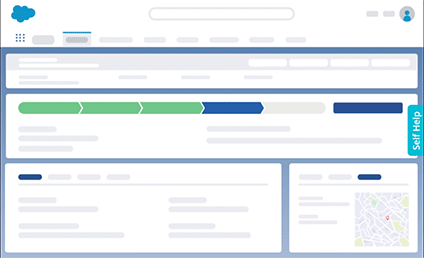

Dharshan Chandran


Whether you’re onboarding new employees or offering professional learning and development to your team, employee training is a continuous and vital part of any organization. But planning and structuring employee training isn’t always easy. How do you know you’re creating the best learning setup for your team while ensuring a significant L&D ROI for your company?
One type of employee training that can be an answer is self-paced learning. Self-paced learning has emerged as a transformative method that empowers individuals to take control of their educational journey.
This article explores the benefits and opportunities offered by self-paced learning, highlighting how this dynamic approach has the potential to revolutionize workplace learning.
Self-paced learning is a flexible educational approach that allows learners to set their own pace and progress for learning at a speed that suits their individual needs and capabilities. This approach gives individuals the freedom to choose when and where to learn, as well as the ability to determine the duration and intensity of the learning sessions.
Unlike traditional classroom settings or structured online courses, self-paced learning empowers learners to take control of their educational journey by providing them with autonomy and flexibility. This approach recognizes that individuals have varying learning styles, preferences, and prior knowledge, enabling them to tailor learning experiences to suit their unique requirements.
Here are some of the most significant benefits of self-paced learning.
One of the primary benefits of self-paced learning is the flexibility it provides. Learners have the freedom to choose when, where, and how they engage with the material. This flexibility allows individuals to adapt their learning to fit their schedules, making it ideal for employees juggling multiple commitments or seeking to upskill while working.
Self-paced, personalized learning allows learners to tailor their educational journey to their specific needs. Individuals can focus more time on challenging topics and quickly move through familiar content. This personalized approach ensures that learners can maximize their understanding and knowledge retention, as they have the flexibility to explore subjects at their own pace.

By granting learners the autonomy to manage their learning, self-paced learning leads to increased engagement and motivation. When individuals have control over their educational experience, they are more likely to take ownership and responsibility for their progress, resulting in a deeper commitment to learning and a higher level of motivation.
Self-paced learning promotes higher learning retention by empowering learners to engage with the material at their own pace and in a manner that suits their individual learning styles. When learners have the freedom to review, revisit, and spend more time on challenging concepts, they can reinforce their understanding and solidify the information in their long-term memory.
Additionally, the personalized nature of self-paced learning enables learners to focus on areas of interest and relevance to them, leading to increased motivation and attention, which are key factors in retaining information.
Self-paced learning can significantly reduce training costs for companies by eliminating or minimizing expenses associated with traditional training methods. It eliminates the need for expensive on-site trainers or instructors, as the learning materials can be pre-recorded or made available online.
Self-paced learning enables employees to learn at their own pace, which reduces the time spent away from work and the associated productivity loss. Additionally, self-paced learning materials can be easily updated and distributed digitally, eliminating the costs of printing, shipping, and distributing physical materials.
While there are significant benefits to self-paced learning, this approach does not come without drawbacks. Some of the disadvantages of self-paced learning include:
Let’s take a closer look at each of these potential cons of self-paced learning.
Unlike traditional classroom learning, where students are face-to-face with their instructors, in a self-paced learning environment, feedback isn’t as readily available. Of course, this doesn’t mean students receive no feedback, but self-paced learners may have to gather feedback virtually in a slightly delayed timeline. This could reduce the value of feedback or make it more challenging to implement as learners are not receiving input in real time as they work through lessons.
Another drawback of self-paced learning is the potential for procrastination by learners. Structured classroom learning provides the exact time and place for learning to occur, typically free from distractions. However, the flexibility and freedom of self-paced learning can also lead to procrastination, as students may put off lessons or modules because they don’t have dedicated time for them.
While allowing students to learn at their own pace and discretion can be a benefit for many types of learners, some might find the plethora of choices available to them to be overwhelming. Choice paralysis or decision paralysis happens when students must select from options that are difficult to compare, leading to no decision being made and procrastination. Furthermore, choice paralysis can take such a toll on the decision-maker that they don’t have the energy to learn effectively even after they make their choice on where to start.
It can also be difficult to properly assess progress in a self-paced learning environment. The flexibility of self-paced learning can make it harder for learners to determine how far they’ve progressed in a course, particularly if they are bouncing around different modules or learning paths. Classroom learning makes monitoring progress much easier as it is structured, and presented more in a step-by-step process.
Finally, the most apparent drawback of self-paced learning is a lack of collaboration. Again, this does not mean it is impossible to collaborate in a self-paced learning environment, but it can be more difficult. In traditional classrooms, students are physically together and able to talk through problems and solutions in real time, while self-paced learners must collaborate virtually or through delayed collaboration, such as social media or forums.
To better understand self-paced learning, we can look at a few different examples of self-paced learning. A self-paced learning approach can be applied to many different situations, but these are some common examples of how companies successfully implement self-paced learning.
Self-paced learning is an evolution of the traditional, classroom-based learning style for corporate teams. Here are a few of the main differences:
| Aspect | Self-Paced Learning | Classroom Learning |
| Pace of Learning | Learners set their own pace and progress through the material independently. | Learning occurs according to a predetermined schedule and pace set by the instructor. |
| Flexibility | Learners have the flexibility to choose when and where to study, accommodating individual schedules. | Learning occurs at specific times and locations, requiring participants to adhere to a set schedule. |
| Personalization | Learners can tailor their learning experience to their specific needs, focusing on areas of interest or relevance. |
Course content is standardized and designed to cater to a group of learners with varied preferences and needs. |
| Instructional Format |
Materials are often presented in digital formats, accessible anytime and anywhere.
| Learning materials are typically presented in person through lectures, discussions, and presentations. |
| Interaction and Support | Communication with instructors and peers may happen virtually or through online platforms. | Face-to-face interaction with instructors and peers is readily available, allowing for immediate feedback and collaborative discussions. |
| Collaboration | Collaboration among learners may occur through online platforms, discussion boards, or virtual meetups. | Collaboration and group work are facilitated through in-person interactions, group activities, and discussions. |
| Pace of Progression | Learners can progress through the material at their own pace, potentially completing courses more quickly. | Learning progresses at a predetermined pace set by the instructor, ensuring all participants move together through the curriculum. |

To incorporate self-paced learning style effectively into your training, here are some tips that are intended to increase engagement, boost motivation, and improve knowledge retention.
Define clear and measurable learning objectives for each course, module, or training topic. Clearly communicate these objectives to learners so they understand what is expected of them and what they will be able to achieve by the end of the learning experience.
Training programs must cater to visual, auditory, and kinesthetic learners, among others, to ensure that participants receive content that aligns with their preferred learning style, maximizing engagement and comprehension.
It’s vital to incorporate a variety of multimedia elements such as videos, interactive simulations, quizzes, and case studies in your self-paced training programs. These engaging resources help maintain learners’ interest, enhance their understanding of the subject matter, and boost knowledge retention.
Developing self-discipline and motivation empowers employees to take ownership of their learning and stay committed to their goals. Self-paced learning requires individuals to set their own schedules, manage their time effectively, and maintain consistency in their study habits.
Cultivating self-discipline helps learners resist distractions, stay focused, and adhere to their learning routines. Setting clear goals, understanding personal motivations, and regularly reminding oneself of the benefits and rewards of learning can help sustain motivation throughout the journey.
Fostering a learning community is instrumental in enhancing self-paced learning as it provides a supportive and collaborative environment for learners. Building a community allows learners to connect with their peers, share insights, and exchange ideas, which enriches the learning experience. Through forums, discussion boards, or virtual meetups, learners can seek clarification, discuss challenging topics, and learn from each other’s perspectives. The community also provides a platform for collaboration, peer feedback, and peer-to-peer learning, which not only enhances understanding but also boosts motivation and engagement.
Utilizing a corporate learning management system (LMS) is highly beneficial for self-paced learning as it provides a centralized platform to facilitate and streamline training programs. An LMS offers various features such as content management, progress tracking, and communication tools that support learners in their self-paced learning journey.
Learners can access course materials, multimedia resources, and interactive activities conveniently through the LMS. Furthermore, the system allows learners and training managers to track learning progress, view completion status, and monitor employee performance, to provide a clear sense of their accomplishment and identify areas that require further attention.
Overall, an LMS streamlines the learning process, promotes organization and accountability, and enhances the overall effectiveness of self-paced learning.
Training employees to use new technology or tools can be time-intensive and frustrating for your team if members don’t learn at the same speed. According to LinkedIn, this type of training is cited as a top challenge for almost a third of learning and development professionals.
Implementing a digital adoption platform like Whatfix takes the pressure off managers and enables self-paced learning for any new technology. With a DAP, you can create interactive walkthroughs, tooltips, and training videos that will guide users step-by-step through each section of a software or application, helping them learn while working.

You can easily integrate Whatfix with your LMS to help employees figure out how to use the software and navigate to different courses. DAPs continue to be useful even after employees feel comfortable with the new technology. As new features and updates are added, the DAP alerts users and takes them to the relevant walkthroughs and self-help menus.

Research suggests that the use of gamified elements in an organization’s L&D courses can significantly boost employees’ engagement and interest. To increase engagement in a self-paced learning environment, you can incorporate gamification in training.
Gamified training incorporates gaming elements such as points and badges into training courses. By leveraging psychology, gamified training engages learners and makes them more willing to take on repetitive tasks despite the risk of failure. This also increases retention, improves the adoption of new software, and improves the performance of individual employees.
For convenient self-paced learning, it is important to make your training materials easily accessible for learners. Apply a self-paced mobile learning strategy instead of synchronous and instructional virtual training. With remote training content made accessible across multiple devices, especially mobile phones, learners can conveniently take courses at their own pace, anytime and anywhere, with no need for trainers.
Combining self-paced learning with microlearning modules, that is, breaking down complex concepts into manageable chunks, ensures convenient consumption of knowledge and better retention. This approach provides concise and engaging content that can be learned quickly while working on daily tasks.
Gather feedback from learners and evaluate the effectiveness of the self-paced learning implementation. Use this feedback to make improvements, update content, and enhance the learning experience. Regularly review and update the materials to ensure they remain relevant and up to date.
Self-paced learning emerges as a dynamic and transformative approach to education in the fast-paced world. By granting learners the freedom to set their own pace, explore their interests, and tailor their learning experience, self-paced learning offers flexibility and personalization that traditional educational methods often lack.
Implementing a digital adoption platform will help you enable and enhance self-paced learning for your organization. By providing interactive guidance, on-screen support, and personalized recommendations, DAPs make it easier for learners to navigate and access the resources they need. This level of support reduces barriers and frustrations, allowing learners to focus on the content and progress at their own pace.
To learn more about Whatfix self-paced learning, schedule a free demo with us today!
Software clicks better with Whatfix's digital adoption platform
Enable your employees with in-app guidance, self-help support, process changes alerts, pop-ups for department announcements, and field validations to improve data accuracy.
Thank you for subscribing!